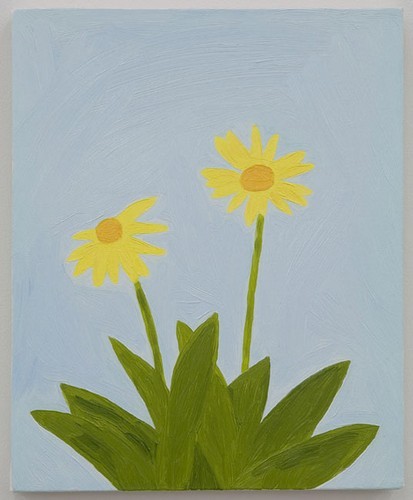Yuko Murata
08 Jan - 07 Feb 2009
YUKO MURATA
EXHIBITION DATES: JANUARY 8 – FEBRUARY 7, 2009
OPENING: OPENING THURSDAY, JANUARY 8, 6 – 8PM
GALLERY HOURS: TUESDAY – SATURDAY, 10AM – 6PM
GALLERY II
Casey Kaplan is pleased to present for the first time in New York, a solo exhibition of Japanese painter, Yuko Murata. Combining Eastern and Western artistic practices, Murata sources her traditional Japanese subject matters in contemporary media such as post cards, tourist brochures, encyclopedias, and magazines. In Gallery II, she will present small, intimate landscapes and depictions of animals in oil on canvas and board.
There is a distance between the world Murata experiences living and working in Tokyo and the imagery that she chooses to consistently render in her work. The simple compositions of her fields are influenced by 18th Century Japanese paintings, when artists were challenged to create an artwork with minimum colors and objects. Iconic Japanese references, such as the karesansui (dry landscape) rock garden, the most famous in the Ryōan-ji Zen temple in Kyoto, Japan; the crane, a symbol of good fortune, peace and longevity; and subtle seasonal references, like barren trees, are repeated themes. When single subjects such as a bird, rock or flower were in the past decorative, narrative, and rooted in Shinto and Buddhist lore, they are now modernly sourced by Murata, serving as her meditations on a lost experience of the world.
Following the traditional style of “yamato-e” meaning simply “Japanese pictures”, Murata’s works are characterized by natural subject matters and frequent use of flat planes of color with very few mid-tones. However, her application of paint is Western in technique. Although very small, Murata’s canvases are rich and they shine behind layers of varnish. Her basic but sophisticated palette varies between works, actively corresponding to the individual subject matters. While each picture maintains beauty and balance, there is a palpable and strange melancholic air that pervades.
Seasonal flowers and plants became the sole focus of compositions during the Momoyama and Edo Periods. Currently, Murata is working on 100 paintings of flowers in homage to Jakuchu Ito (1716-1800), who produced a painting of a hundred flowers at the Kotohira-gu shrine in Shikoku, Japan in 1764. An ancient Japanese tradition grants a wish to the person who folds 1000 origami cranes. In a similar act, Murata paints, working through her subjects.
Yuko Murata was born in Kangawa, Japan and studied at the Tokyo Art School, Setsu Mode Seminar, graduating in 1995. Recent solo exhibitions include: “the Songs of Birds,” Lammfromm, Tokyo, Japan and “Ikejiri Institute of Design”, curated by Hideo Nakayasu, Tokyo. Since 2002, she has exhibited in Tokyo at Gallery Side 2. Group exhibitions include “New and Rising Artists 2007”, curated by Norimasa Nishimatsu, at the Pola Museum Annex, Tokyo in 2007, and in 2006, "Dirty Yoga", curated by Dan Cameron, Taipei Biennial, Taipei Fine Arts Museum.
EXHIBITION DATES: JANUARY 8 – FEBRUARY 7, 2009
OPENING: OPENING THURSDAY, JANUARY 8, 6 – 8PM
GALLERY HOURS: TUESDAY – SATURDAY, 10AM – 6PM
GALLERY II
Casey Kaplan is pleased to present for the first time in New York, a solo exhibition of Japanese painter, Yuko Murata. Combining Eastern and Western artistic practices, Murata sources her traditional Japanese subject matters in contemporary media such as post cards, tourist brochures, encyclopedias, and magazines. In Gallery II, she will present small, intimate landscapes and depictions of animals in oil on canvas and board.
There is a distance between the world Murata experiences living and working in Tokyo and the imagery that she chooses to consistently render in her work. The simple compositions of her fields are influenced by 18th Century Japanese paintings, when artists were challenged to create an artwork with minimum colors and objects. Iconic Japanese references, such as the karesansui (dry landscape) rock garden, the most famous in the Ryōan-ji Zen temple in Kyoto, Japan; the crane, a symbol of good fortune, peace and longevity; and subtle seasonal references, like barren trees, are repeated themes. When single subjects such as a bird, rock or flower were in the past decorative, narrative, and rooted in Shinto and Buddhist lore, they are now modernly sourced by Murata, serving as her meditations on a lost experience of the world.
Following the traditional style of “yamato-e” meaning simply “Japanese pictures”, Murata’s works are characterized by natural subject matters and frequent use of flat planes of color with very few mid-tones. However, her application of paint is Western in technique. Although very small, Murata’s canvases are rich and they shine behind layers of varnish. Her basic but sophisticated palette varies between works, actively corresponding to the individual subject matters. While each picture maintains beauty and balance, there is a palpable and strange melancholic air that pervades.
Seasonal flowers and plants became the sole focus of compositions during the Momoyama and Edo Periods. Currently, Murata is working on 100 paintings of flowers in homage to Jakuchu Ito (1716-1800), who produced a painting of a hundred flowers at the Kotohira-gu shrine in Shikoku, Japan in 1764. An ancient Japanese tradition grants a wish to the person who folds 1000 origami cranes. In a similar act, Murata paints, working through her subjects.
Yuko Murata was born in Kangawa, Japan and studied at the Tokyo Art School, Setsu Mode Seminar, graduating in 1995. Recent solo exhibitions include: “the Songs of Birds,” Lammfromm, Tokyo, Japan and “Ikejiri Institute of Design”, curated by Hideo Nakayasu, Tokyo. Since 2002, she has exhibited in Tokyo at Gallery Side 2. Group exhibitions include “New and Rising Artists 2007”, curated by Norimasa Nishimatsu, at the Pola Museum Annex, Tokyo in 2007, and in 2006, "Dirty Yoga", curated by Dan Cameron, Taipei Biennial, Taipei Fine Arts Museum.

